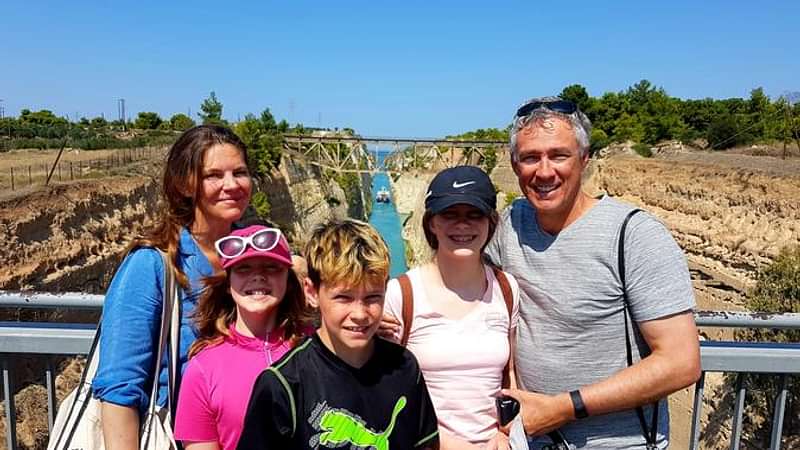
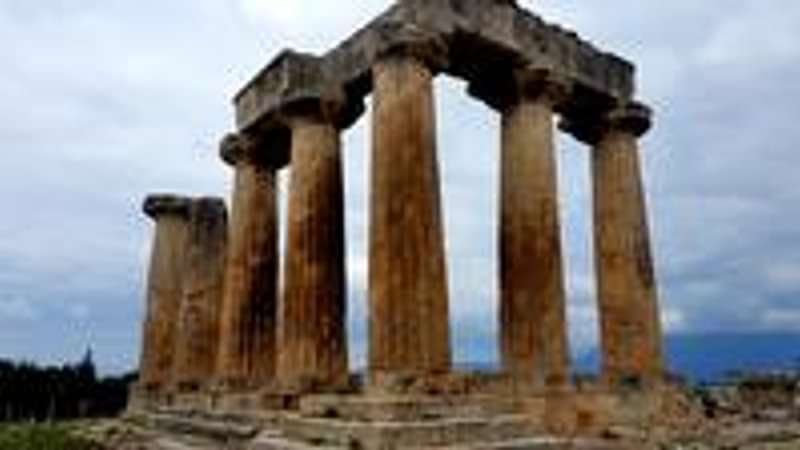

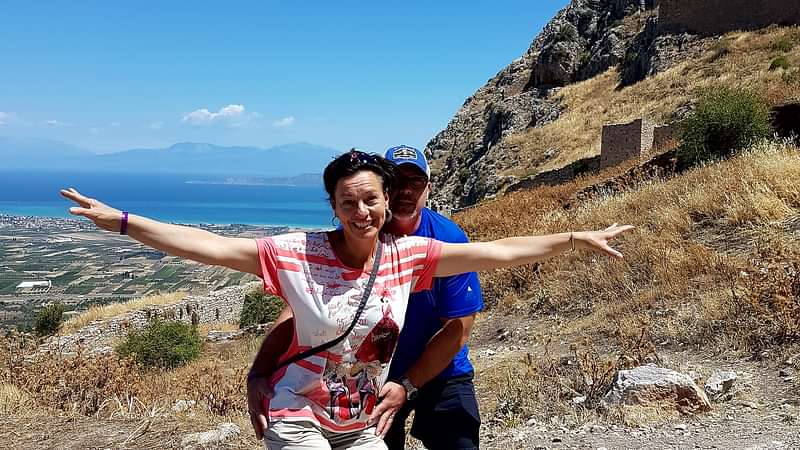
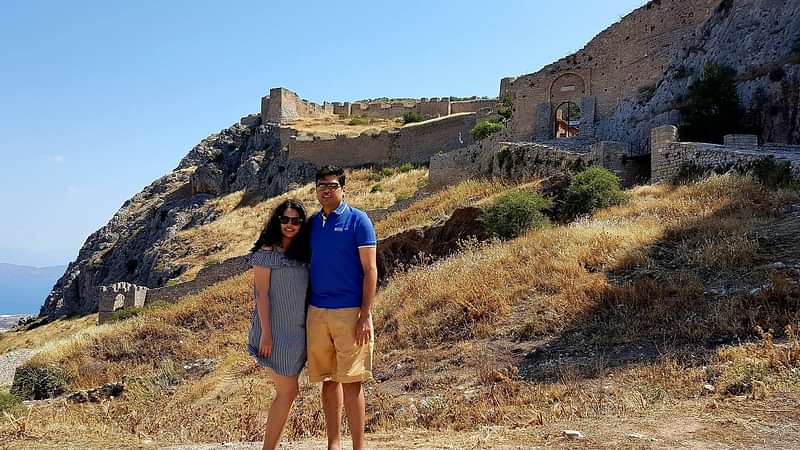

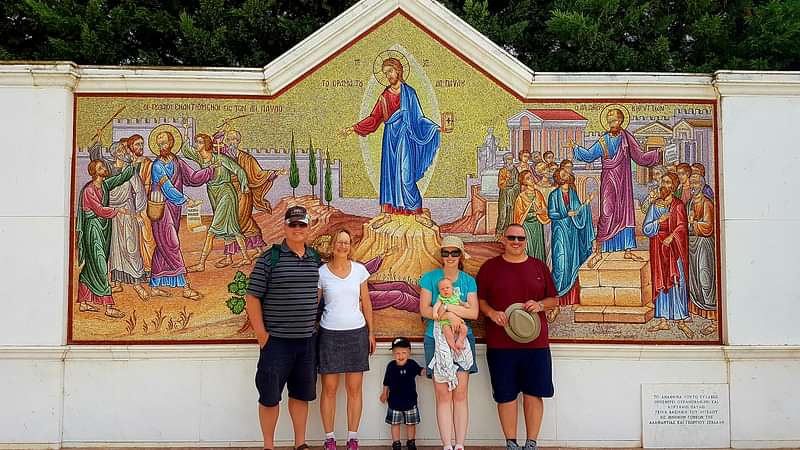
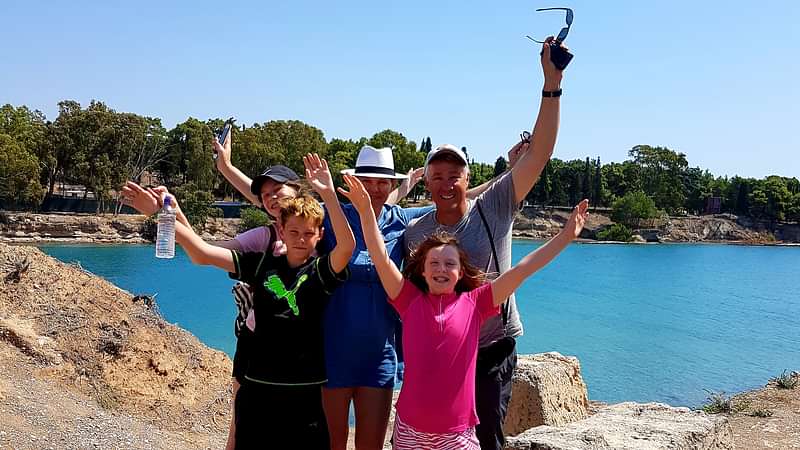
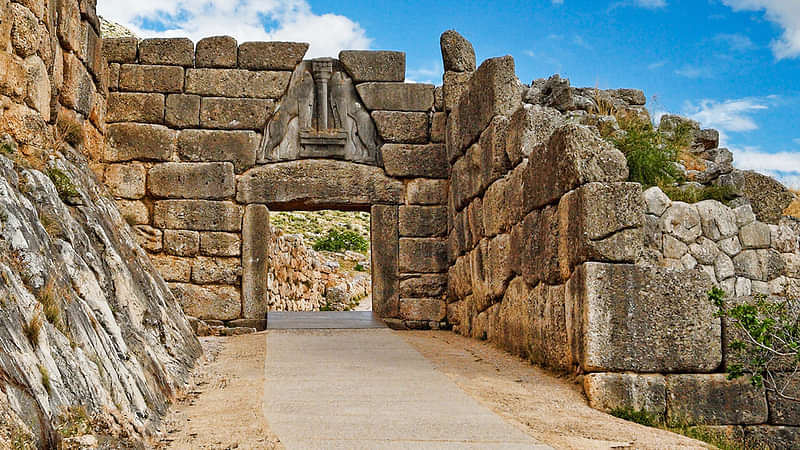
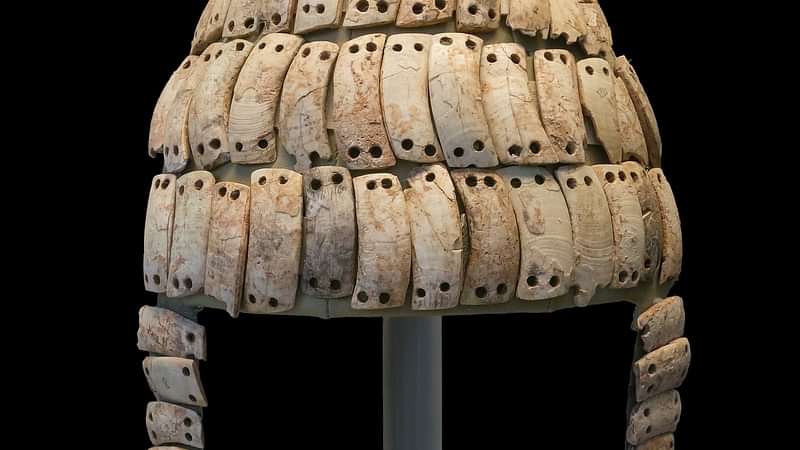
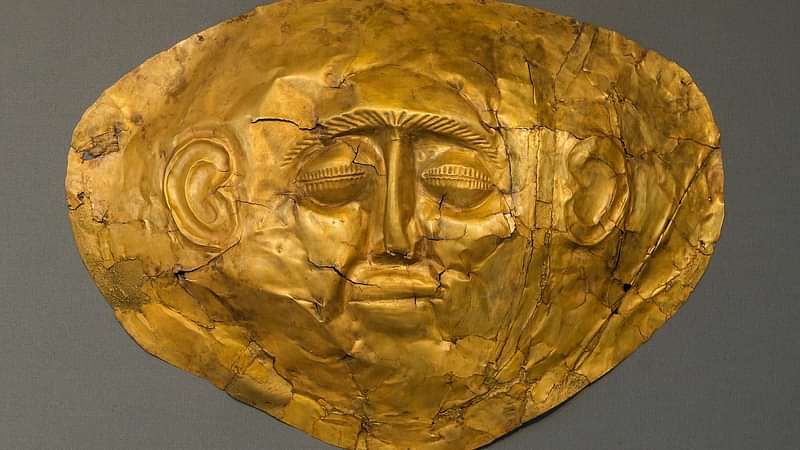
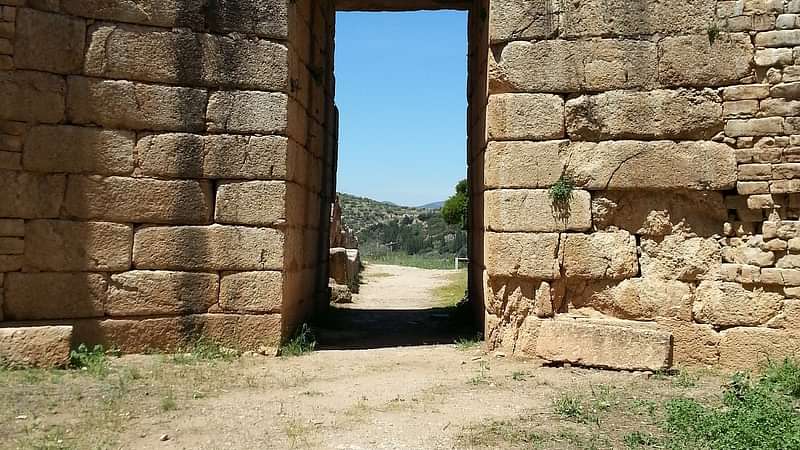
- Duration: 8 hours
- Easy
-
Electronic Voucher
- Pick up available
- Friendly cancellation policy
- Best price guarantee!
- Easy online booking
- Contact us for questions
Description
Be amazed by the modern engineering masterpiece of the Corinth Canal (Isthmus Canal).
Explore the large citadel of Acrocorinth. Through its imposing entrance gates, you will enter the castle and you will discover its hidden gems. You will also experience the spectacular panoramic views which will amaze you.
Witness the ancient town of Corinth, one of the richest towns in Ancient Greece, where St. Paul lived and preached for two years. We will visit the ruins of the ancient city in which you can see the remains of the Agora and one of the most outstanding monuments of pre –Roman period, the temple of Apollo.
Relive the expedition to Troy at Mycenae, the kingdom of Agamemnon and a World Heritage UNESCO Site.
Itinerary
Isthmus Canal, Ancient Corinth & Mycenae Tour
Isthmus Canal
- Visit the Isthmus Canal, one of the most important projects and 19th century engineering masterpieces, playing a catalytic role for the Mediterranean trade.
- Visit Ancient Diolkos, a paved trackway in Ancient Greece which enabled boats to be moved overland across the Isthmus of Corinth.
Acrocorinth
- Visit Acrocorinth, the acropolis of ancient Corinth, a monolithic rock overseeing the ancient city of Corinth. It is one of the most impressive and dominant acropoleis of the Peloponnese.
- Gates: A system of 3 circuit walls reinforced by towers.
- Keep
- Peirene Spring: Located within the encircling walls, a gift of Asopus to Sisyphus.
- Temple of Aphrodite: On the highest of the two picks of the mountain are traces of the temple of Aphrodite on the site.
- Frankish Tower: At the SW edge of the precipitous rock fortified during Frankish times forming the inner keep of the fortress. Remains of churches, mosques, houses, fountains and cisterns are preserved here.
- Views of Geraneia Mountain: Enjoying breathtaking views of the Corinthian gulf and the SW coast of the Peloponnese.
Ancient Corinth
- Hadgimoustafa spring: a fountain built during the Ottoman empire.
- Ancient Corinth Archaeological Museum: Housing a large collection of artifacts from the local site and from smaller sites in the neighboring area.
- Temple of Apollo: One of the earliest Doric temples in the Peloponnese and the Greek mainland with monolithic columns, rare in the ancient world, built around 560 BCE.
- Agora: A rectangular construction 160 m long and 70 m wide, consisting of central shops, small temples and altar and the renowned podium or Bema from where Apostle Paul addressed the Corinthians in 52 AD.
- Roman buildings.
- Bema or Pedestal
- Theatre and Odeon/Asklepieion
- Lechaion road: Facing the Corinthian gulf leading to the port of Lechaion.
- St. Paul's church: Admiring a magnificent mosaic mural depicting Saul's vision from Christ as he was travelling to Damascus to persecute the Christians.
- Treat yourself to an authentic "village style" lunch on a magnificent terrace overlooking ancient Corinth's archaeological site and the temple of Apollo.
- Stroll amongst the village shops where you can treat yourself and buy handmade souvenirs for your family and friends.
Mycenae
Rich in gold! King Agamemnon's mythical kingdom sung in Homer's epics. It is the most important and richest center of the late Bronze Age.
- The Lions Gate: The main entrance of the Bronze age citadel of Mycenae erected during the 13th century BC.
- Grave Circles A and B: Royal cemeteries situated to the south of the Lion Gate and outside the Bronze Age citadel.
- The Cyclopean Walls: The main characteristic of the Mycenean walls is that they are made of huge limestone boulders. Only the mythical Cyclopes had the strength to move the enormous boulders that made up the walls of Mycenae and Tiryns.
- The Royal Palace: Consisting of domestic apartments, the Throne Room Suite, the Grand Staircase, a collection of rooms for officers or palace officials and the Forecourt.
- The Treasury of Atreus: A large tholos or beehive tomb constructed during the Bronze Age around 1250 BC.
- Tomb of Clytemnestra: A Mycenean tholos type tomb built in 1250 BC named after Clytemnestra the wife of king Agamemnon and leader of the Greeks in Trojan war.
- The Mycenean Archaeological Museum: The most important Mycenean artifacts are exhibited here. You will be dazzled by the gold grave goods, burial masks, jewellery, weapons, worship idols and frescoes.
Pick up locations
- Piraeus Cruise Terminal A, B, C, Akti Miaouli
- Electra Hotel Athens, 5 Ermou
- Electra Metropolis Hotel, Mitropoleos 15
- Electra Palace Athens, Navarhou Nikodimou 18-20, Athens, Plaka
- A For Athens , Miaouli 2
- A77 Suites by Andronis, Adrianou 77
- Academia of Athens, Autograph Collection, 38 Akadimias Street, Omirou Street
- Achilleas Hotel, 21 Lekka, Syntagma/ Plaka
- Achillion Hotel, 32 Agiou Konstadinou,
- Piraeus Port, Piraeus
- Four Seasons Astir Palace Hotel Athens, Apollonos 40
- Acropolian Spirit Boutique Hotel, 7 Syngrou Avenue
- Acropole Hotel, 7 Gounari Dimitriou,
- Acropolis Ami Boutique Hotel, 10 Iras Street,
- Acropolis Hill Hotel, 7 Mousson
- Acropolis Museum Boutique Hotel, 48 Syngrou Avenue Plaka,
- Acropolis Holmes Residence, Leoforos Andrea Siggrou 37
- Acropolis View Hotel, Webster 10, Acropolis - Koukaki
- Acropolis Select Hotel, 37-39 Falirou,
- Hotel Acropolis House, 6-8 Kodrou Str.
- Divani Palace Acropolis, 19 - 25 Parthenonos,
- Brown Acropol, Panagi Tsaldari 1
- Acropol Hotel, 71 Pentelis Ave,
- Acropolis Plaza Smart Hotel and Spa, Iasonos 47
- AD Athens Luxury Rooms and Suites, Athanasiou Diakou 4, Makrygianni
- Alter Athens Hotel, Zoodochou Pigis 100
- Andronis Athens, Karaiskaki 33 str
- Ares Athens Hotel, Pireos 7
- Arion Athens Hotel, 18 Agiou Dimitriou (Psirri), Plaka/ Monastiraki
- Art Suites Athens, 3 Sevastias, Ilisia
- Astor Hotel Athens, 16 Karagiorgi Servias, Syntagma Square
- Athenaeum Eridanus Luxury Hotel, Pireos 78
- Athenaeum Grand Hotel, 142 Syngrou Avenue
- Athenaeum Palace & Luxury Suites, Leof. Andrea Siggrou 123
- Athenaeum Smart Hotel, 127 Sygrou Ave.
- Athens Atrium Hotel & Suites, 21 Okeanidon, Agiou Sostis, Syngrou Av
- Athens Avenue Hotel, Syggrou Avenue 182
- Athens Capital Hotel – Mgallery Collection, Eleftheriou Venizelou 4
- Athens Center Square, 15 Aristogitonos, Monastiraki / Plaka/ Psyri
- Athens City Hotel, Patision 232,
- Athens City Plaza, 43 Veranzerou Street
- Athens Coast Hotel, Grigoriou Lampraki 25
- Athens Cypria Hotel, 5 Diomias, Athens - Syntagma
- Athens Delta Hotel, 27 Kerameon Str., Metaxourgio
- Athens Diamond Homtel, 24 Voulis, Mitropoleos
- Athens Diamond Plus, 24 Voulis Str. & Mitropoleos Str.,
- Athens Habitat, 5 Saronikou,
- Athens Ikon Hotel, 21 Mitropoleos, Syntagma
- Athens International Airport, Athens International Airport
- Athens Iris Hotel, Domokou 2
- Athens Ivy Suites, Petraki 11
- Athens House Hostel, Aristotelous 4,
- Athens Lotus Hotel, 9 Chiou,
- Athens Lights Hotel, 3 Klisovis
- Athens Luxury Suites, Avramiotou 12
- Athens Lydia Hotel, 121 Liossion,
- Athens Manor House, Athinaidos 2
- Athens Mansion Luxury Suites, Evripidou 11
- Athens Market Portrait, Evripidou 40 Str.
- Athens Marriott Hotel, 385 Syngrou Avenue
- Athens Odeon Hotel, 42 Pireos,
- Athens One Smart Hotel, Veranzerou 50 & Marnis
- Athens Psiri Hotel, 32 Sofokleous
- Athens Platinum Rooms and Suites, Zagoras 16, And Messinias
- Athens Starlight Hotel, Agathonos 9
- Athens Tiare Hotel, Peiraios 2, Plateia Omonoias
- Athens Utopia Ermou, 46 Ermou
- Athens Zafolia Hotel, Leoforos Alexandras 87-89,
- Athens21, Athinas 21
- Athensotel.Com, 8 Agias Eleousis
- AthensWas, 5 Dionissiou Tou Areopagitou
- Villa Brown Ermou, Petraki 26
- Coral Hotel Athens, 35 Leoforos Possidonos
- Glyfada Riviera Hotel, 40 Poseidonos avenue and Nafsikas,
- Palace Hotel Glyfada Athens, Posidonos Av, 4
- Emmantina Hotel, Poseidonos 33,
- Palmyra Beach Hotel, 70 Leoforos Possidonos,
- Civitel Olympic Hotel, 2a Kifissias Avenue,
- Royal Olympic, 28-34 Athanasiou Diakou Str.,
- Best Western Plus Embassy Hotel, 22 Timoleontos Vassou Street,
- Kubic Athens Hotel, 26 Agiou Konstantinou
- King George, a Luxury Collection Hotel, Athens, 3 Vassileos Georgiou A, Syntagma Square
- St. George Lycabettus Lifestyle Hotel, 2 Kleomenous,
- NJV Athens Plaza, 2 Vassileos Georgiou A', Syntagma Square
- Grand Hyatt Athens, 115 Syngrou Avenue
- Hotel Grande Bretagne, A Luxury Collection Hotel, 1 Vasileos Georgiou A' str., Syntagma Square
- Wyndham Grand Athens, 2 Megalou Alexandrou
- Pallas Athena Grecotel Boutique Hotel, 65 Athinas & Lykourgou Str., Kotzia Square
- Elia Ermou Athens Hotel, Ermou 15
- Melia Athens, Chalkokondili 14, 28 Oktovriou Str.
- Plaka Arch Suites, Frinichou 2
- Plaka Hotel, 7, Kapnikareas street and corner of Mitropoleos, Plaka / Acropolis / Syntagma / Monastiraki
- Astor Hotel, Schillerstr. 24,
- Coco-Mat Athens BC, 5 Falirou
- COCO-MAT Athens Jumelle, 2 Ipsilantou
- Coco-Mat Hotel Athens, 36 Patriarchou Loakeim Street
- Coco-Mat Hotel Nafsika, 6 Pellis,
- Perianth Hotel, 2, Limpona Street
- The Athens Gate Hotel, 10, Sygrou Avenue,
- Divani Caravel Hotel, Leoforos Vasileos Alexandrou 2,
- Apollonion Hotel, 1 Leonidou,
- Apollo Hotel, 10 Achilleos Street, Metaxourghio Square
- Vouliagmeni Suites, Panos 8
- Divani Apollon Palace & Thalasso, Agiou Nikolaou 10
- Ergon House, 23 Mitropoleos Street
- President Hotel, 43 Kifissias Leoforos,
- ibis Styles Athens Routes, Leoforos Vouliagmenis 109
- NLH Fix - Neighborhood Lifestyle Hotels, Syggrou 64, Stratigou Kontouli
- Lozenge Hotel, Valaoritou 6, Voukourestiou Str
- Airotel Parthenon, 6 Makri,
- Arethusa Hotel, 6-8 Mitropoleos,
- Amalia Hotel, 10 Amalias Ave.,
- Pan Hotel, 11 Mitropoleos, Syntagma Square
- The Marblous Athens, Voulis 24
- Dorian Inn Hotel, 15-19 Pireos Street,
- InnAthens, Georgiou Souri 3, Filellinon
- The Pinnacle Athens, Eolou 75 & Evripidou
- Emporikon Athens Hotel, 27, Aiolou Street, Plaka
- Elikon Hotel, Dorou 3
- Hotel Athinaikon, 40 Evripidou,
- Hotel Kosmikon, 7 Sokratous,
- Hotel Pringhipikon, 27 Veranzerou,
- Mosaikon, Kolokotroni 61
- Hotel Vassilikon, 5 Iktinou,
- Muse Urban Suites, Ifestou 26
- Urban Frame Hotel, Nikis 40
- Omiros Hotel, 15 Apollonos, Syndagma Square - Plaka
- Central Athens Hotel, Apollonos 21,
- Hotel Nefeli, Iperidou 16, Agiou Hatzimichali 2, Plaka
- Kimon Hotel Athens, 27 Apollonos,
- The Zillers Boutique Hotel, Mitropoleos 54,
- Classic Hotel by Athens Prime Hotels, Chavriou 7
- Holiday Inn Athens Attica Avenue Airport West, Attica Avenue 40.2 km, Between Exits 17 & 18
- Hotel Carolina, 55 Kolokotroni,
- Hotel Oniro, 57 Trikoupi Spiridonos,
- The Dolli, Mitropoleos 49
- Adams Hotel, 6 Cherefodos, at Thalou
- Klepsydra, 1 Aristidou
- Noma Hotel, 11 Athinaidos
- The Gem Society Boutique Hotel & Spa, Aristidou 3
- Hotel Phedra,
- AVA Hotel Athens, 9 - 11 Lyssikratous Street, Plaka
- Adrian Hotel, 74 Adrianou,
- Home and Poetry, Lisikratous 10
- Crowne Plaza Hotel - Athens City Centre, 50 Michalakopoulou,
- Moxy Athens City, Stadiou 65
- Wyndham Athens Residence, Achilleos 2
- Hellenic Vibes Smart Hotel, Agias Irinis 7
- The Editor Athens Hotel, 5-7 Voreou & Karori
- Athens Starlight Hotel, Agathonos 9
- Athens Color Cube Luxury Apartments, Aiolou 43
- Royalty Hotel Athens, Athinas 6
- Pallada Athens Boutique Rooms & Suites, Pallados 17
- Attalos Hotel, 29 Athinas str., Monastiraki
- Cecil Hotel Athens, 39 Athinas, Monastiraki
- Airotel Alexandros, Timoleontos Vassou 8,
- Airotel Stratos Vassilikos Hotel, 114 Michalakopoulou,
- Titania Hotel, 52 Panepistimiou Avenue,
- Zappion Hotel, 4 Ironda,
- Adonis Hotel, Kodrou & Vouls Streets Chrissostomou 3,
- Hotel Olympic, Hans-Sachs-Str. 4,
- Museum Hotel, 16, Bouboulinas Str,
- Fresh Hotel, 26 Sofokleous,
- Economy Hotel, 5 Klisthenous,
- Niche Hotel Athens, 21 Syngrou Avenue & 2 Vourvachi
- Herodion Hotel, 4 Rovertou Galli Street,
- Philippos Hotel, 3 Mitseon,
- Evripides Hotel, 79 Evripidou,
- Hotel Elite, 23 Pireos,
- O & B Athens Boutique Hotel, Leokoriou 7
- Alma Hotel, 5 Dorou,
- Polis Grand Hotel, 19 Patission, 10 Veranzerou
- B4B Athens Signature Hotel, Menaimahou 1 & Theofilopoulou 18, Callirois Avenue
- B4B Athens 365 Hotel, Fragkoudi & Sygrou Avenue 138
- The Foundry Suites, Sarri 38
- Sea View Hotel, Xanthou 4,
- The Athenian Callirhoe Exclusive Hotel, 32 Kallirrois,
- Mirabello Hotel, 49 Geraniou, Omonia Sq
- Ambrosia Suites, 52 Sokratous
- Diros Hotel, 21 Street Konstantinou,
- Dave Red Athens, a member of Brown Hotels, Veranzerou 25
- Hotel Parnon, 20 Triti Septemvriou & 21 Chalkokondili Str,
- Epidavros Hotel, Koumoundourou 14,
- Modernist Athens Hotel, Ioanni Gennadiou 4
- Marina Hotel Athens, 13 Voulgari Street, Citycenter,
- Jason Inn, 12 Agion Assomaton
- Jason Prime, 3 Nikiforou, Omonia Square
- King Jason Hotel, 26 Kolonou,
- Radisson Blu Park Hotel Athens, 10 Leoforos Alexandras
- Hotel Thissio, Agias Marinis 2 & Apostolou Pavlou 25,
- Hotel Orpheus, 58 Chalkokondili,
- Hotel Keramicos, 30 Keramikou,
- Phidias Piraeus Hotel, 189 Koudouriotou, Pasalimani
- Orion & Dryades Hotel, Emmanouel Benaki 105 & Anexartisias 5, Lofos Strefi Park, Exarchia
- Pythagorion Hotel, 28 Agiou Konstandinou Street,
- Nestorion Hotel, 8 Pedelis, Amfithea,Beside Onasi
- InterContinental Athenaeum, 89 - 93 Syngrou Ave,
- Delice Hotel - Family Apartments, 3 Leoforos Vassileos Alexandrou,
- Stalis Hotel, 10, Akominatou St & Agiou Konstantinou St,
- Art Hotel, Marni 27
- The Stanley, 1 Odisseos Street, Karaiskaki Square
- Novotel Athenes, Michail Voda 4,
- Candia Hotel, 40 Theodore Diligianni Street,
- Brasil Suites Hotel Apartments, 4 Eleftherias, 4 Elefterias Street Glyfada
- Brazil Hotel, 62 Filis, Victoria Square
- Hotel Socrates, Neofitou Metaxa 27-29, Larissis Station
- Hotel Ariston, Neofitou Metaxa 35 & Diligianni 50, Station Larissis
- Hotel Aristoteles, 15 Acharnon, Vathis Square
- Hotel Aristofanis, 38 Aristofanous,
- Filoxenia Hotel, 50 Acharnon,
- Hotel Diethnes, 52 Peoniou,
- Hotel Semeli, 16 Thiras, Plateia Amerikis
- Hotel Roy, Rodou 15,
- Poseidon Athens Hotel, 72 Poseidonos Avenue,
- Blue Sea Hotel, 49 - 53 Themistokleous,
- Galaxy Hotel, 39 Posidonos Ave. & Kalamakiou,
- Chroma Fashion Hotels, Leoforos Pentelis 5, Corner with Papagos
- Tropical Hotel, 74 Leoforos Possidonos,
- Hotel Giorgio, Kipoupoleos 4 & Samou
- Civitel Attik Rooms & Apartments, 11 Olimpias,
- Hotel Ikaros, 17 Leoforos Possidonos,
- Hotel Kreoli, 17 Vassileos Georgiou B,
- Somewhere Boutique Hotel Vouliagmeni, Agiou Panteleimonos
- Oasis Hotel Apartments, 27 Possidonos,
- Congo Palace Hotel, Posidonos 81A,
- Hotel Theoxenia, 6 Gladstonos,
- Theoxenia Palace Hotel, 2 Filadelfeos Street,
- Piraeus Theoxenia Hotel, 23 Karaoli & Dimitriou,
- Ionion Hotel Piraeus, 10 Kapodistriou,
- Piraeus Dream City Hotel, 78 - 80 Navarchou Notara, Notara 78-80
- Piraeus Port Hotel, 12 Evaggelistrias
- Crystal City Hotel, 4 Achilleos,
- Crystal Hotel, 4 Achilleos,
- Semiramis, 48 Charilaou Trikoupi Str.,
- Dekelia Hotel, 23 Kifisias Str., Tatoi - Kifissia
- Golden Sun Hotel, 72 Dimarchou Angelou Metaxa Street & Kritis Square,
- The Golden Age Hotel of Athens, 57 Michalakopoulou,
- Pines Hotel, Helidonous 78, Artemidos
- Minavra Hotel, 2 Metaxa Ioanni,
- Domotel Kastri Hotel, Eleftheriou Venizelou 154, Romylias
- The Margi, Litous 11
- Gatsby Athens , Lekka 18
- Athens Tower Hotel by Palladian Hotels, Athinas 2
- Athens City View, Aiolou 31
- 14 Reasons Why , Miaouli 21
What's included
- Hotel/port pickup and drop-off
- Pickup and drop-off from designated meeting points
- Private tour
- Transport by private vehicle
- Transport by air-conditioned minivan
- Native English speaking drivers
- Refreshment wipes
- Bottled water
What do I need to bring
- casual non slip shoes
- sunscreen
Important information
- Confirmation will be received at time of booking
- Infant seats available on request
Cancellation policy
- Cancellation fee of 100% if cancelled 1 day or less before departure
Categories
- DAY TRIPS AND EXCURSIONS
- CULTURAL AND THEME TOURS
- EDUCATIONAL TOUR
- MUSEUMS AND EXHIBITIONS
- PHOTOGRAPHY
- PRIVATE CAR TOUR
- PILGRIMAGE OR RELIGION
- PRIVATE ROUNDRIP
- SHOPPING
- SIGHTSEEING
- SIGHTSEEING ATTRACTION
- TRANSFERS AND GROUND TRANSPORT
- SKIP THE LINE
- WALKING TOUR
Guided Language
- English
- Ελληνικά
Reviews!
8 hours


